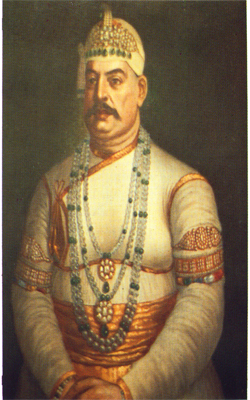
|
|
|
Mir Farkhunda Au Khan Nasir-ud-Daula was born in Bidar on 25th April 1794. He was the eldest son of Sikander Jah and after his father’s death he succeeded him on 23rd May, 1829. During the reign of his father a number of British officers were employed on several civil service posts but the new Nizam resolved to dispense with their services. Hence on ascending the throne in 1829 one of the first acts of His Highness was to request the Governor General, Lord William Bentinck,to withdraw the European officers. The Governor General acceded to the Nizam’s request.
In 1832 Munir-ul-Mulk who was the Minister died and Raja Chandulal was made the Minister. Raja Chandulal had the reputation of being a friend of the British. Sir Henry Russell who was the Resident in Hyderabad had established a Contingent. The cost of maintaining the Contingent resulted in deterioration of Nizam’s finances.
In 1838 General J.S. Fraser succeeded Col. J. Stewart as the Resident. In 1843 Raja Chandulal resigned as the Minister and in his place his nephew Raja Ram Baksh was appointed but in 1846 he also resigned and was succeeded by Siraj-ul--MuIk. During his period several reforms were carried out, and a system of revenue administration based on modern principles was evolved. Contractors and middlemen were eliminated. The State was divided into sixteen districts each in charge of a Taluqdar who was responsible for civil and judicial administration of his district.
On the recommendation of Nawab Siraj-ul-Mulk, Nasir-ud-Daula introduced a social reform of great significance. This was the law prohibiting “Sati” or the burning of Hindu widows along with their dead husbands.
In 1848 Nawab Siraj-ul-Mulk also resigned when Amjad-ul-Mulk and Nawab Shams-ud-Daula held office for short periods. In 1849 Raja Ram Baksh was again recalled as the Minister.
Financial crisis in the Dominion continued and in 1851 Nawab Siraju l-Mulk was again recalled to act as Minister. This time when he assumed office the Government was overburdened with debts and the State treasury was empty. To meet the expenses some of the jewels of the Nizam had to be mortgaged. This situation arose mainly due to the heavy expenses incurred in maintaining the British Contingent in the State.
In 1853 when General Fraser left Hyderabad and in his place General C.B. Low took over as the Resident, he received a message from Lord Dalhousie to inform the Nizam to pay sixty-four lakh rupees which were due to the British for maintaining the Contingent, or else the British demanded territorial cession to liquidate the debt.
Nizam informed the Resident that he was not in favour of maintaining the Contingent and offered Rs. 50 lakh but the British insisted on full settlement. The whole object of the British was to acquire more territory from the Nizam.
The arrears of the Contingent caused great anxiety. In 1853 the Government could not make the payment to the Contingent for six months. The Nizam felt that something should be done to prevent the British from resorting to any serious action. Raja Chandulal appealed to the British for a loan of one crore rupees to clear the debts, in lieu of which he offered to assign territory yielding an annual revenue of seventeen lakh rupees. On 16th September 1843 Raja Chandulal was allowed to retire and he died on 15th April 1845.
On 20th May, 1853 a new treaty was conluded by which the strength of the Contingent force was settled for its payments.
As a result the Nizam ceded to the British, Berar and some border districts upto Sholapur with the Doab between the Krishna and Tungabhadra rivers yielding a gross annual revenue of over Rs. 50 lakh. By this treaty which was concluded on 21st May, 1853 the Nizam while retaining the full use of the Subsidiary Force was to be relieved from the obligation of services in times of war. The Contingent ceased to be a part of the Nizam’s Army and became an auxiliary force kept by the British Government for the benefit of Hyderabad State. The Berar treaty became the cause of cold war between the two governments for almost a hundred years afterwards.
Nawab Siraj—ul-Mulk was so much taken aback by this treaty that he died within a week of its implementation.
After the death of Nawab Siraj—ul-Mulk his nephew, Mir Turab Au Khan Salar Jung, was made the Minister with the title Mukhtar-ul-Mulk. Salar Jung took over the administration of the Dominion at a very critical period with limited finances and strained relations between the Nizam and the British. However, despite all these handicaps Salar Jung introduced several reforms and reorganised the administrative machinery. These reforms resulted in improved finances and increased the prestige of the Dominion. During this period, the Dominion was divided into 16 districts each under a Taluqdar who was entrusted with the civil and judicial administration of the district.
Regular records were prepared annually of the land under cultivation, the nature of crop, name of the occupant and the amount payable. A ryot who could not pay the due amount at the appointed time was allowed to pay in instalments. During the time of Sir Salar Jung the Chaderghat Bridge was constructed.
After ruling for 28 years Nawab Nasir—ud—Daula died on 16th May 1857 at the age of 64 and was buried in the Mecca Masjid Royal Cemetery. He was survived by two sons, the elder son was Nawab Afzalu d-Daula and the younger Nawab Roushan-ud-Daula.
|
|